2020年初三英语中考冲刺训练 环境保护阅读与练习 (含答案)
文档属性
| 名称 | 2020年初三英语中考冲刺训练 环境保护阅读与练习 (含答案) | 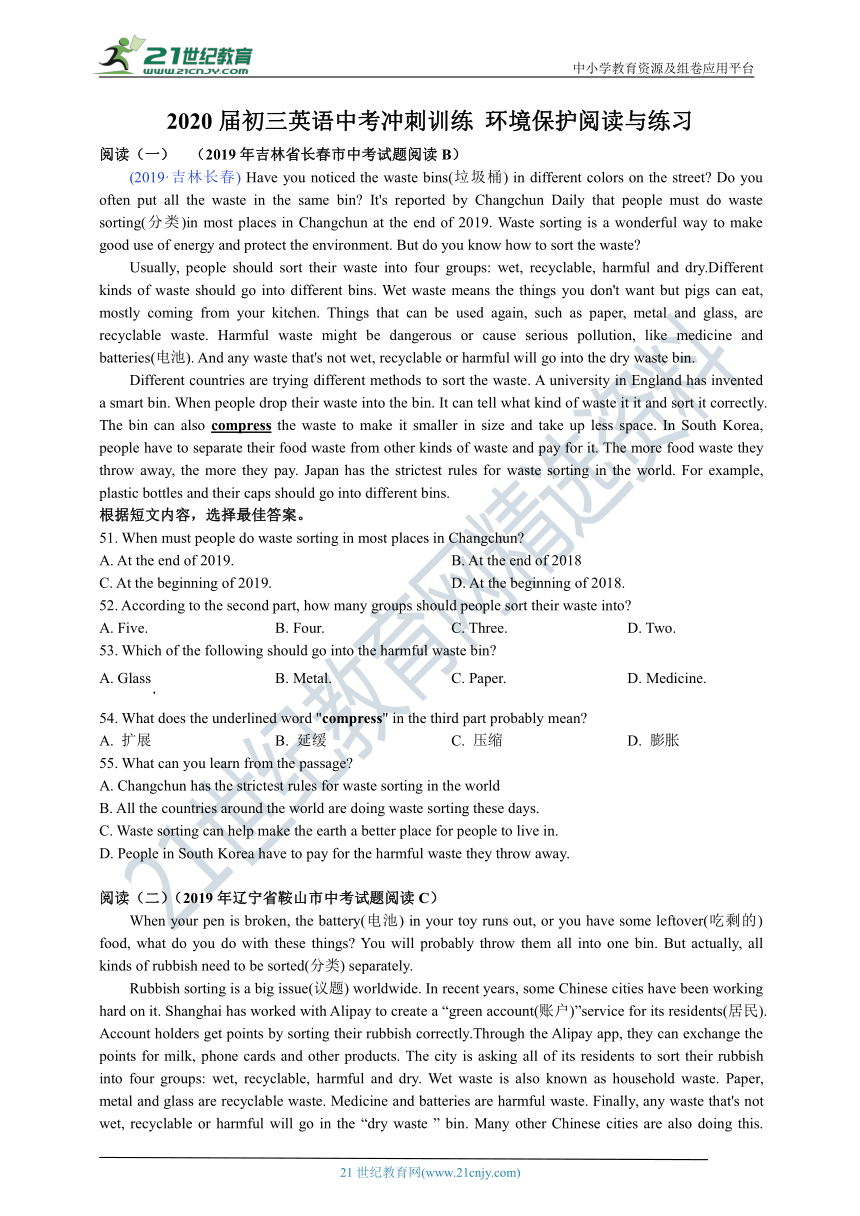 | |
| 格式 | zip | ||
| 文件大小 | 1.5MB | ||
| 资源类型 | 试卷 | ||
| 版本资源 | 牛津译林版 | ||
| 科目 | 英语 | ||
| 更新时间 | 2020-04-16 18:31:20 | ||
图片预览

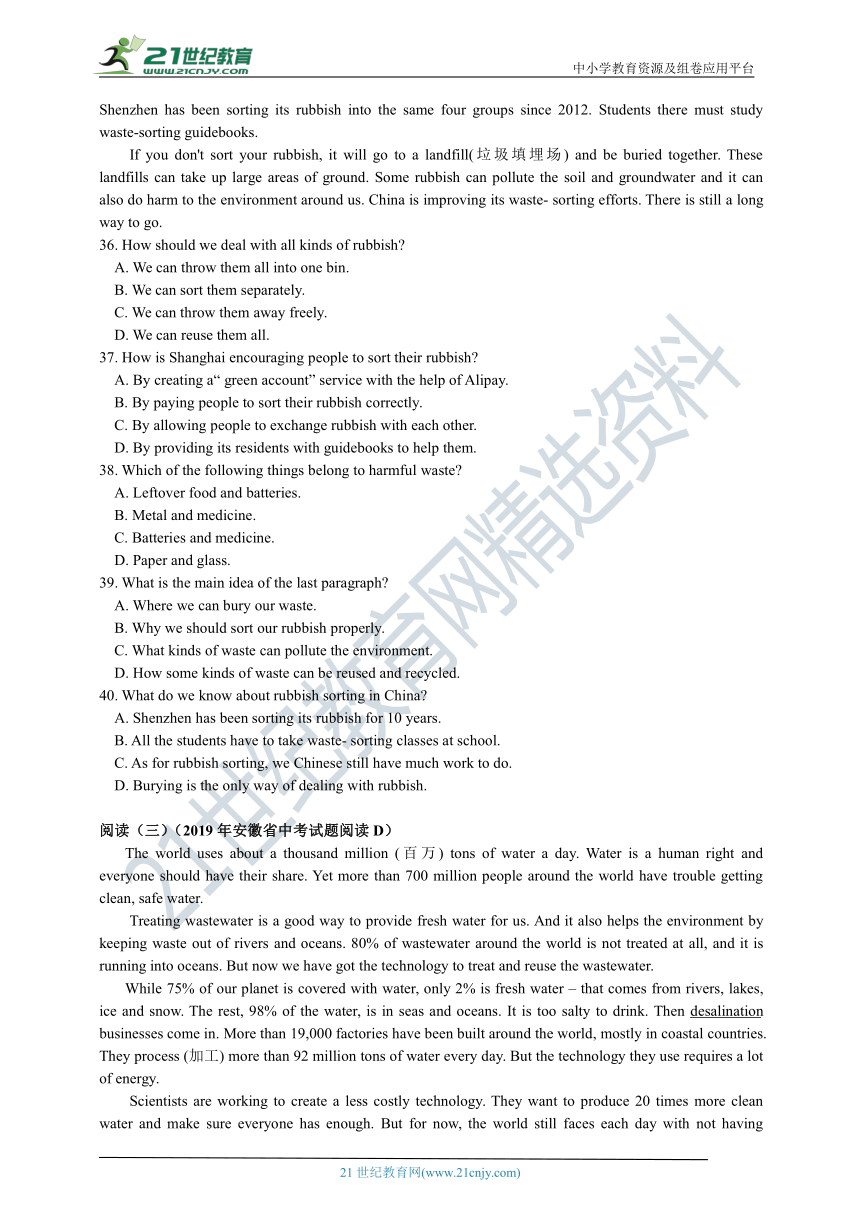
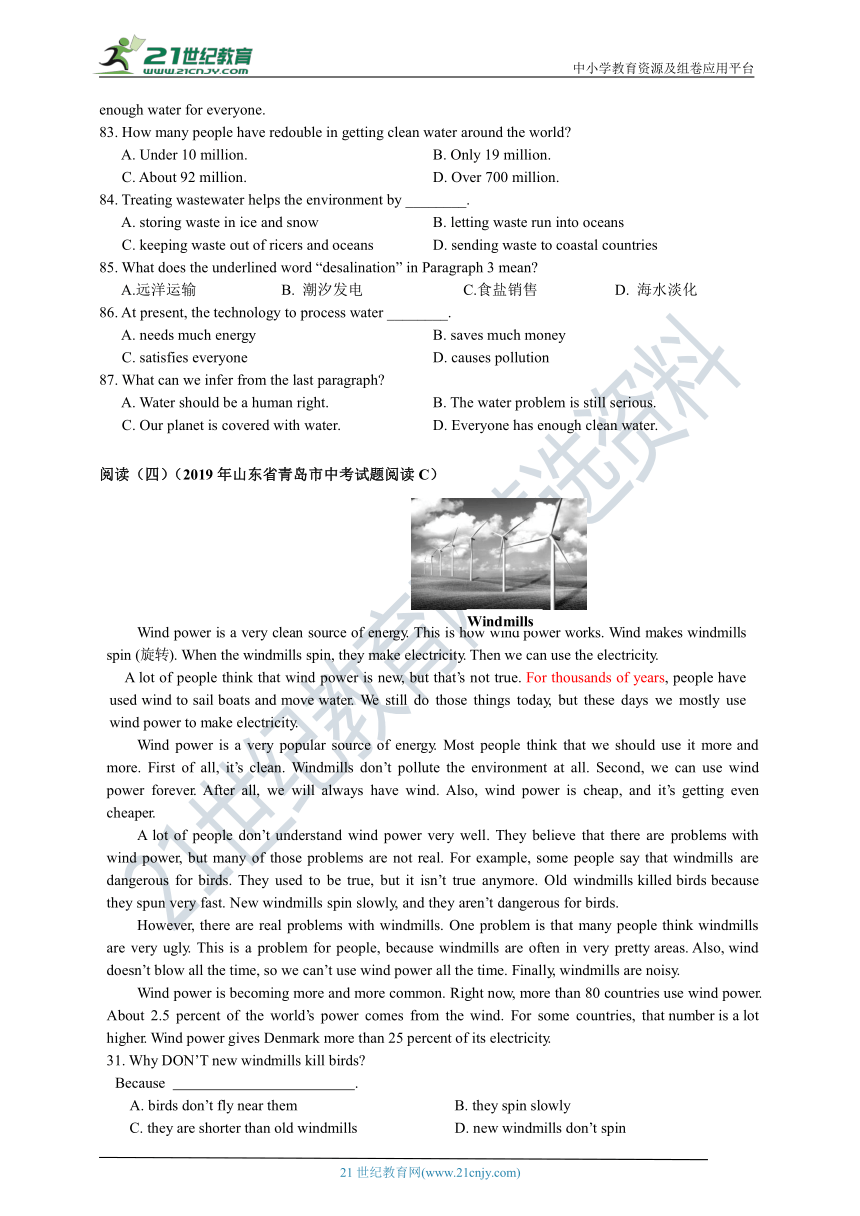
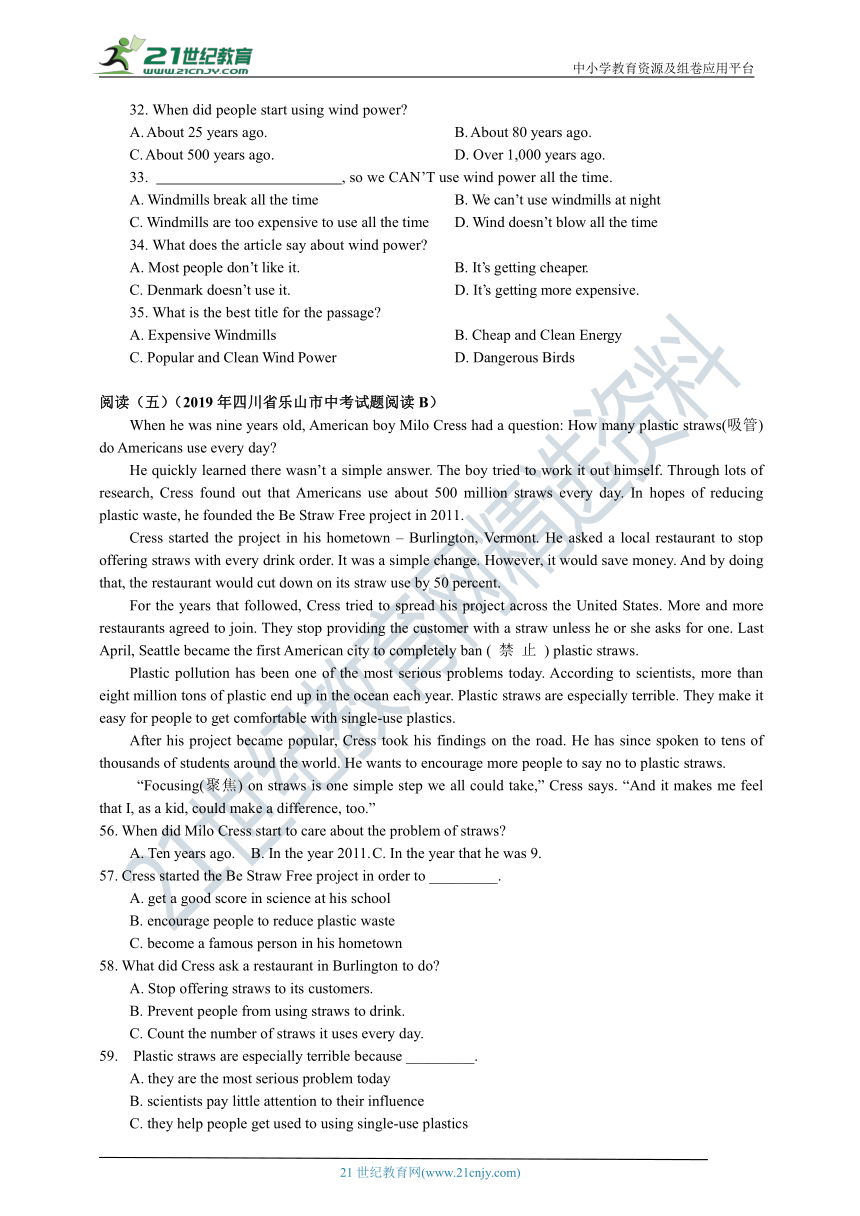
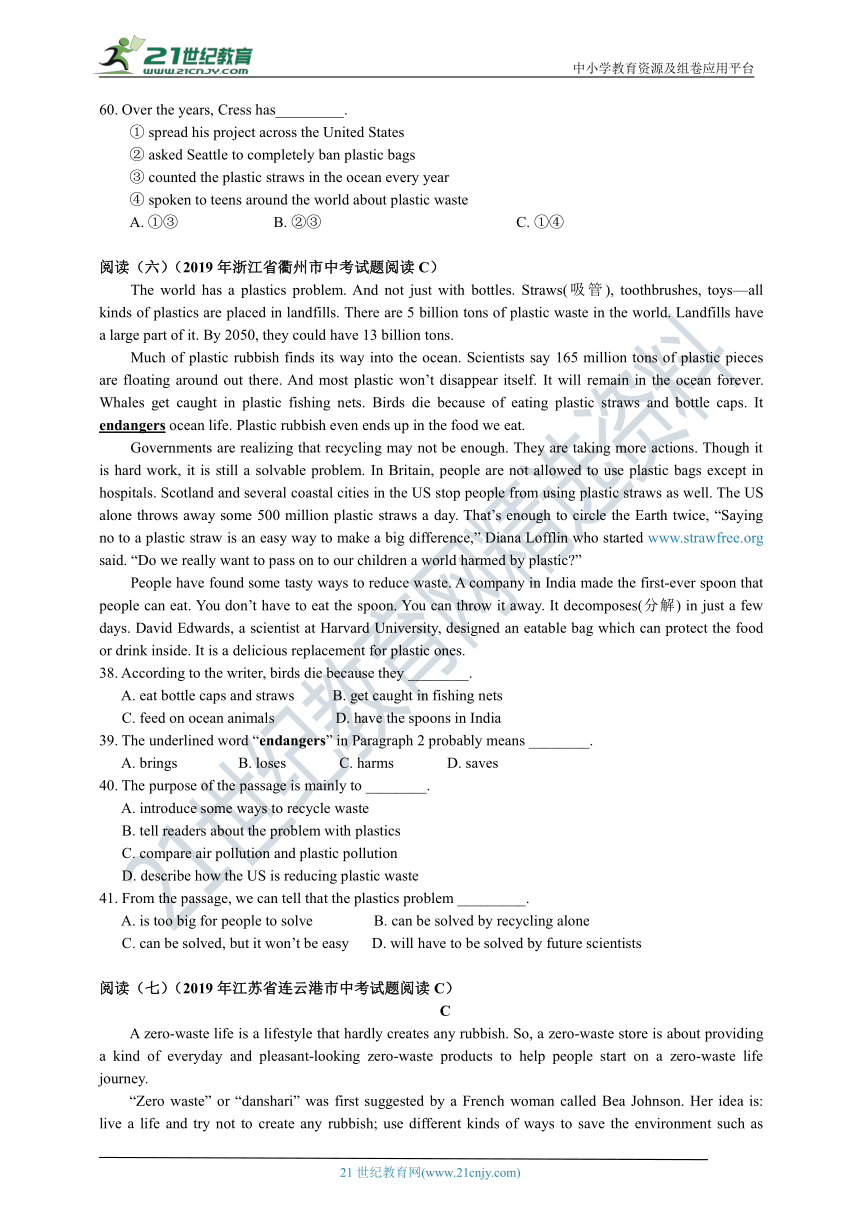
文档简介
中小学教育资源及组卷应用平台
2020届初三英语中考冲刺训练 环境保护阅读与练习
阅读(一) (2019年吉林省长春市中考试题阅读B)
(2019·吉林长春) Have you noticed the waste bins(垃圾桶) in different colors on the street? Do you often put all the waste in the same bin? It's reported by Changchun Daily that people must do waste sorting(分类)in most places in Changchun at the end of 2019. Waste sorting is a wonderful way to make good use of energy and protect the environment. But do you know how to sort the waste?
Usually, people should sort their waste into four groups: wet, recyclable, harmful and dry.Different kinds of waste should go into different bins. Wet waste means the things you don't want but pigs can eat, mostly coming from your kitchen. Things that can be used again, such as paper, metal and glass, are recyclable waste. Harmful waste might be dangerous or cause serious pollution, like medicine and batteries(电池). And any waste that's not wet, recyclable or harmful will go into the dry waste bin.
Different countries are trying different methods to sort the waste. A university in England has invented a smart bin. When people drop their waste into the bin. It can tell what kind of waste it it and sort it correctly. The bin can also compress the waste to make it smaller in size and take up less space. In South Korea, people have to separate their food waste from other kinds of waste and pay for it. The more food waste they throw away, the more they pay. Japan has the strictest rules for waste sorting in the world. For example, plastic bottles and their caps should go into different bins.
根据短文内容,选择最佳答案。
51. When must people do waste sorting in most places in Changchun?
A. At the end of 2019. B. At the end of 2018
C. At the beginning of 2019. D. At the beginning of 2018.
52. According to the second part, how many groups should people sort their waste into?
A. Five. B. Four. C. Three. D. Two.
53. Which of the following should go into the harmful waste bin?
A. Glass B. Metal. C. Paper. D. Medicine.
54. What does the underlined word "compress" in the third part probably mean?
A. 扩展 B. 延缓 C. 压缩 D. 膨胀
55. What can you learn from the passage?
A. Changchun has the strictest rules for waste sorting in the world
B. All the countries around the world are doing waste sorting these days.
C. Waste sorting can help make the earth a better place for people to live in.
D. People in South Korea have to pay for the harmful waste they throw away.
阅读(二)(2019年辽宁省鞍山市中考试题阅读C)
When your pen is broken, the battery(电池) in your toy runs out, or you have some leftover(吃剩的) food, what do you do with these things? You will probably throw them all into one bin. But actually, all kinds of rubbish need to be sorted(分类) separately.
Rubbish sorting is a big issue(议题) worldwide. In recent years, some Chinese cities have been working hard on it. Shanghai has worked with Alipay to create a “green account(账户)”service for its residents(居民). Account holders get points by sorting their rubbish correctly.Through the Alipay app, they can exchange the points for milk, phone cards and other products. The city is asking all of its residents to sort their rubbish into four groups: wet, recyclable, harmful and dry. Wet waste is also known as household waste. Paper, metal and glass are recyclable waste. Medicine and batteries are harmful waste. Finally, any waste that's not wet, recyclable or harmful will go in the “dry waste ” bin. Many other Chinese cities are also doing this. Shenzhen has been sorting its rubbish into the same four groups since 2012. Students there must study waste-sorting guidebooks.
If you don't sort your rubbish, it will go to a landfill(垃圾填埋场) and be buried together. These landfills can take up large areas of ground. Some rubbish can pollute the soil and groundwater and it can also do harm to the environment around us. China is improving its waste- sorting efforts. There is still a long way to go.
36. How should we deal with all kinds of rubbish?
A. We can throw them all into one bin.
B. We can sort them separately.
C. We can throw them away freely.
D. We can reuse them all.
37. How is Shanghai encouraging people to sort their rubbish?
A. By creating a“ green account” service with the help of Alipay.
B. By paying people to sort their rubbish correctly.
C. By allowing people to exchange rubbish with each other.
D. By providing its residents with guidebooks to help them.
38. Which of the following things belong to harmful waste?
A. Leftover food and batteries.
B. Metal and medicine.
C. Batteries and medicine.
D. Paper and glass.
39. What is the main idea of the last paragraph?
A. Where we can bury our waste.
B. Why we should sort our rubbish properly.
C. What kinds of waste can pollute the environment.
D. How some kinds of waste can be reused and recycled.
40. What do we know about rubbish sorting in China?
A. Shenzhen has been sorting its rubbish for 10 years.
B. All the students have to take waste- sorting classes at school.
C. As for rubbish sorting, we Chinese still have much work to do.
D. Burying is the only way of dealing with rubbish.
阅读(三)(2019年安徽省中考试题阅读D)
The world uses about a thousand million (百万) tons of water a day. Water is a human right and everyone should have their share. Yet more than 700 million people around the world have trouble getting clean, safe water.
Treating wastewater is a good way to provide fresh water for us. And it also helps the environment by keeping waste out of rivers and oceans. 80% of wastewater around the world is not treated at all, and it is running into oceans. But now we have got the technology to treat and reuse the wastewater.
While 75% of our planet is covered with water, only 2% is fresh water – that comes from rivers, lakes, ice and snow. The rest, 98% of the water, is in seas and oceans. It is too salty to drink. Then desalination businesses come in. More than 19,000 factories have been built around the world, mostly in coastal countries. They process (加工) more than 92 million tons of water every day. But the technology they use requires a lot of energy.
Scientists are working to create a less costly technology. They want to produce 20 times more clean water and make sure everyone has enough. But for now, the world still faces each day with not having enough water for everyone.
83. How many people have redouble in getting clean water around the world?
A. Under 10 million. B. Only 19 million.
C. About 92 million. D. Over 700 million.
84. Treating wastewater helps the environment by ________.
A. storing waste in ice and snow B. letting waste run into oceans
C. keeping waste out of ricers and oceans D. sending waste to coastal countries
85. What does the underlined word “desalination” in Paragraph 3 mean?
A.远洋运输 B. 潮汐发电 C.食盐销售 D. 海水淡化
86. At present, the technology to process water ________.
A. needs much energy B. saves much money
C. satisfies everyone D. causes pollution
87. What can we infer from the last paragraph?
A. Water should be a human right. B. The water problem is still serious.
C. Our planet is covered with water. D. Everyone has enough clean water.
阅读(四)(2019年山东省青岛市中考试题阅读C)
Wind power is a very clean source of energy. This is how wind power works. Wind makes windmills spin (旋转). When the windmills spin, they make electricity. Then we can use the electricity.
A lot of people think that wind power is new, but that’s not true. For thousands of years, people have used wind to sail boats and move water. We still do those things today, but these days we mostly use wind power to make electricity.
Wind power is a very popular source of energy. Most people think that we should use it more and more. First of all, it’s clean. Windmills don’t pollute the environment at all. Second, we can use wind power forever. After all, we will always have wind. Also, wind power is cheap, and it’s getting even cheaper.
A lot of people don’t understand wind power very well. They believe that there are problems with wind power, but many of those problems are not real. For example, some people say that windmills are dangerous for birds. They used to be true, but it isn’t true anymore. Old windmills killed birds because they spun very fast. New windmills spin slowly, and they aren’t dangerous for birds.
However, there are real problems with windmills. One problem is that many people think windmills are very ugly. This is a problem for people, because windmills are often in very pretty areas. Also, wind doesn’t blow all the time, so we can’t use wind power all the time. Finally, windmills are noisy.
Wind power is becoming more and more common. Right now, more than 80 countries use wind power. About 2.5 percent of the world’s power comes from the wind. For some countries, that number is a lot higher. Wind power gives Denmark more than 25 percent of its electricity.
31. Why DON’T new windmills kill birds?
Because .
A. birds don’t fly near them B. they spin slowly
C. they are shorter than old windmills D. new windmills don’t spin
32. When did people start using wind power?
A. About 25 years ago. B. About 80 years ago.
C. About 500 years ago. D. Over 1,000 years ago.
33. , so we CAN’T use wind power all the time.
A. Windmills break all the time B. We can’t use windmills at night
C. Windmills are too expensive to use all the time D. Wind doesn’t blow all the time
34. What does the article say about wind power?
A. Most people don’t like it. B. It’s getting cheaper.
C. Denmark doesn’t use it. D. It’s getting more expensive.
35. What is the best title for the passage?
A. Expensive Windmills B. Cheap and Clean Energy
C. Popular and Clean Wind Power D. Dangerous Birds
阅读(五)(2019年四川省乐山市中考试题阅读B)
When he was nine years old, American boy Milo Cress had a question: How many plastic straws(吸管) do Americans use every day?
He quickly learned there wasn’t a simple answer. The boy tried to work it out himself. Through lots of research, Cress found out that Americans use about 500 million straws every day. In hopes of reducing plastic waste, he founded the Be Straw Free project in 2011.
Cress started the project in his hometown – Burlington, Vermont. He asked a local restaurant to stop offering straws with every drink order. It was a simple change. However, it would save money. And by doing that, the restaurant would cut down on its straw use by 50 percent.
For the years that followed, Cress tried to spread his project across the United States. More and more restaurants agreed to join. They stop providing the customer with a straw unless he or she asks for one. Last April, Seattle became the first American city to completely ban ( 禁 止 ) plastic straws.
Plastic pollution has been one of the most serious problems today. According to scientists, more than eight million tons of plastic end up in the ocean each year. Plastic straws are especially terrible. They make it easy for people to get comfortable with single-use plastics.
After his project became popular, Cress took his findings on the road. He has since spoken to tens of thousands of students around the world. He wants to encourage more people to say no to plastic straws.
“Focusing(聚焦) on straws is one simple step we all could take,” Cress says. “And it makes me feel that I, as a kid, could make a difference, too.”
56. When did Milo Cress start to care about the problem of straws?
A. Ten years ago. B. In the year 2011. C. In the year that he was 9.
57. Cress started the Be Straw Free project in order to _________.
A. get a good score in science at his school
B. encourage people to reduce plastic waste
C. become a famous person in his hometown
58. What did Cress ask a restaurant in Burlington to do?
A. Stop offering straws to its customers.
B. Prevent people from using straws to drink.
C. Count the number of straws it uses every day.
59. Plastic straws are especially terrible because _________.
A. they are the most serious problem today
B. scientists pay little attention to their influence
C. they help people get used to using single-use plastics
60. Over the years, Cress has_________.
① spread his project across the United States
② asked Seattle to completely ban plastic bags
③ counted the plastic straws in the ocean every year
④ spoken to teens around the world about plastic waste
A. ①③ B. ②③ C. ①④
阅读(六)(2019年浙江省衢州市中考试题阅读C)
The world has a plastics problem. And not just with bottles. Straws(吸管), toothbrushes, toys—all kinds of plastics are placed in landfills. There are 5 billion tons of plastic waste in the world. Landfills have a large part of it. By 2050, they could have 13 billion tons.
Much of plastic rubbish finds its way into the ocean. Scientists say 165 million tons of plastic pieces are floating around out there. And most plastic won’t disappear itself. It will remain in the ocean forever. Whales get caught in plastic fishing nets. Birds die because of eating plastic straws and bottle caps. It endangers ocean life. Plastic rubbish even ends up in the food we eat.
Governments are realizing that recycling may not be enough. They are taking more actions. Though it is hard work, it is still a solvable problem. In Britain, people are not allowed to use plastic bags except in hospitals. Scotland and several coastal cities in the US stop people from using plastic straws as well. The US alone throws away some 500 million plastic straws a day. That’s enough to circle the Earth twice, “Saying no to a plastic straw is an easy way to make a big difference,” Diana Lofflin who started www.strawfree.org (?http:?/??/?www.strawfree.org?) said. “Do we really want to pass on to our children a world harmed by plastic?”
People have found some tasty ways to reduce waste. A company in India made the first-ever spoon that people can eat. You don’t have to eat the spoon. You can throw it away. It decomposes(分解) in just a few days. David Edwards, a scientist at Harvard University, designed an eatable bag which can protect the food or drink inside. It is a delicious replacement for plastic ones.
38. According to the writer, birds die because they ________.
A. eat bottle caps and straws B. get caught in fishing nets
C. feed on ocean animals D. have the spoons in India
39. The underlined word “endangers” in Paragraph 2 probably means ________.
A. brings B. loses C. harms D. saves
40. The purpose of the passage is mainly to ________.
A. introduce some ways to recycle waste
B. tell readers about the problem with plastics
C. compare air pollution and plastic pollution
D. describe how the US is reducing plastic waste
41. From the passage, we can tell that the plastics problem _________.
A. is too big for people to solve B. can be solved by recycling alone
C. can be solved, but it won’t be easy D. will have to be solved by future scientists
阅读(七)(2019年江苏省连云港市中考试题阅读C)
C
A zero-waste life is a lifestyle that hardly creates any rubbish. So, a zero-waste store is about providing a kind of everyday and pleasant-looking zero-waste products to help people start on a zero-waste life journey.
“Zero waste” or “danshari” was first suggested by a French woman called Bea Johnson. Her idea is: live a life and try not to create any rubbish; use different kinds of ways to save the environment such as stopping the use of one-off objects; giving unwanted things to others or giving them away to organizations like the Red Cross.
Yu Yuan, 27, is deeply interested in this idea. She and her boyfriend have lived in Beijing for many years. And earlier she used to buy things without thinking about them carefully until she saw a video about “zero waste”, in which a family of four placed the rubbish they produced every year in a jar (罐). After watching the video, Yu wanted to experience this zero-waste lifestyle with her boyfriend.
A zero-waste life follows the 6 R rule—Refuse, Reduce, Reuse, Repair, Recycle and Rot. Over August October when Yu followed the rule of zero waste 6 R, she and he boyfriend Joe Harvey both produced only two cans of rubbish.
Now, the couple have opened a small shop in Beijing, where they use wood products to take the place of plastic ones and cloth bags with environmentally friendly logos. Most products sold in the store can be reused. The store also has second-hand books and CDs/DVDs with ideas to make the best of the used things.
“Those who once experienced the non-waste lifestyle have slowly changed their ideas,” says Yu. “The zero-waste lifestyle is not for ascetics (苦行僧). It is just around us at our finger-tips.” Yu expects some of her friends to join her on the road to zero waste.
38.Bea Johnson suggests that people should ________.
A.try to produce no rubbish in life B.share objects with others
C.help their friends live comfortably D.work hard for the Red Cross
39.We can see from the passage that Yu Yuan ________.
A.offers plastic bags in her store B.is influenced by the 6 R rule
C.often buys things she doesn’t need D.likes listening to CDs very much
40.What Yu Yuan says in the last paragraph probably means that ________.
A.lots of people doubt the zero-waste lifestyle
B.she feels it hard to continue her lifestyle
C.her friends have followed her lifestyle
D.the zero-waste lifestyle is not difficult to live
41.Which of the following is the best title for the passage ?
A.Opening up a second-hand store B.Recycling waste
C.Saving the environment D.Joining the couple
阅读(八)(2019年江苏省苏州市中考试题阅读C)
Every day there is less and less space on Earth for rubbish. Yet every day we make more and more rubbish. What can we do? We can recycle some of our rubbish. Recycling means that the rubbish will be made into something that can be used again.
Recycling helps Earth. And it saves space in rubbish dumps. Half of everything that we put into landfills could be recycled instead. In fact, most things made of paper, metal, glass and plastic can be recycled.
Paper can be broken into small pieces and made into new paper. Steel and aluminum cans(金属罐)can be melted down(熔化)and made into new cans. The same is true of glass bottles. This can be done over and over again. Recycling doesn't take as much energy as making these things the first time. So we can use less of Earth's fuel resources.
Plastic can be melted down, too. Then it can be formed into park benches, playgrounds and so on. Some people call plastic the "wood" of the future. Things made of plastic will last about 400 years—even if they stay outside in the weather. No wood can do that!
27. The underlined word "landfills" in Paragraph 2 probably means _____________.
A. bench factories B. places for rubbish
C. green mountains D. recycling centers
28. According to the passage, what happens last to the can?
A. The can is put into a recycling bin. B. The can is melted down and reused.
C. A steel can gets filled with corn. D. A person uses the corn in the can.
29. What is the main idea of the passage?
A. Cans should be melted down.
B. Old newspapers can be reused.
C. We can build benches that last 400 years.
D. We should recycle everything that we can.
阅读(九)(2019年湖南省株洲市中考试题阅读C)
Protecting the earth is like protecting our eyes. People's attention to recycling is increasing. From recycling plastic bags to using environment friendly products, there are many developments to be seen in almost every corner of the world.
Sweden is a worldwide leader in recycling. They open world's first mall for repaired and recycled goods.It's called ReTuna, a two-story building in Eskilstuna, Sweden, about 70 miles west of Stockholm. The clever thing about this mall is its position. It's right next to the city's recycling centre. So a stream of ears is already coming to drop off unwanted household things. This produces a supply of things for the shops. There are 14 special shops. When goods arrive, a team sorts everything into categories (类别) . The mall only sells goods that are recycled or “upcycled”, meaning unwanted things broken down and reinvented as something new. By doing so, 50 new jobs were created in repair and retail (零售) .
“You can come and just do sustainable shopping and Sweden loves it. And the world loves it, ” said Anna Bergstrom, the manager of the ReTuna Mall. “I think it’s fun to find something that people have used, and we can use further," said Cato Limas, a ReTuna customer(顾客). “If you look at the things they're selling here, they're almost new. So actually, why do you need. to buy new things?"
These unwanted things found new homes. In 2018, the mall sold second-hand goods worth $1.3million.
46. The Sweden's first mall for repaired and recycled goods is __________.
A. ReTuna B. Eskilstuna C. Anna Bergstrom
47. How many new jobs were created in repair and retail?
A.14. B.50. C. 70.
48. What does the underlined word “sustainable” in Paragraph 3 mean?
A. Lucky. B. Private. C. Environment friendly.
49. Who is Cato Limas?
A. A manager. B. A customer. C. A driver.
50. The passage mainly talks about __________.
A. shopping is Sweden
B. making more energy
C. the mall selling second-hand goods
阅读(十)(2019年甘肃省兰州市中考试题阅读C)
At 8,844,43 meters high, Mount Qomolangma is the tallest mountain on Earth. While it is famous for its beautiful views, parts of the mountain are facing a problem: rubbish. Every year, thousands of visitors throw away tons of rubbish, such as bottles and plastic bags.
According to the UN, over 140 tons of rubbish has been left on the mountain. To reduce rubbish, China is limiting (限制) the number of people who are allowed to climb up the north side of the mountain. Only 300 people will be allowed to climb it, and only during spring.
Local people cleaned the mountain last year, removing rubbish at a height of 5,200 meters. They collected about 8.4 metric tons (公吨) of rubbish.
This year, the local government plans to spend 4 million yuan on a new clean-up activity. The local government is also setting up stations to sort (分类), recycle and break down rubbish collected from the mountain. A group of artist will also try to turn the rubbish into art works. They will show these works of art to remind people not to leave rubbish when climbing the mountain.
61. What problem are parts of Mount Qomolangma facing?
A. Air pollution. B. Rubbish.
C. Noise. D. Water pollution.
62. How many people will be allowed to climb up the north side of the mountain during spring?
A.140. B. 5,200. C. 4 million. D. 300.
63. The underlined word “removing” in Paragraph3 probably means ____.
A. using up B. making better
C. putting on D. taking away
64. The artists will show their art works in order to ____.
A. teach people to make works of art
B. help people to know about Qomolangma
C. encourage people to clean up Qomolangma
D. remind people not to throw rubbish on Qomolangma
65. What kind of writing is this?
A. A notice. B. News.
C. A story. D. An advertisement.
参考答案
阅读(一)
【答案】51. A 52. B 53. D 54. C 55. C
【解析】
这篇短文主要讲述了垃圾分类是一种很好的利用能源和保护环境的方法。文中讲述了垃圾如何分类,垃圾分类有助于使地球成为人们居住的好地方。
【51题详解】
细节理解。根据文中It's reported by Changchun Daily that people must do waste sorting(分类)in most places in Changchun at the end of 2019.可知,在2019年末。故选A。
【52题详解】
细节理解。根据文中Usually, people should sort their waste into four groups: wet, recyclable, harmful and dry.可知,通常,人们应该把垃圾分为四类:湿的、可回收的、有害的和干燥的。故选B。
【53题详解】
细节理解。根据文中Harmful waste might be dangerous or cause serious pollution, like medicine and batteries(电池).可知,药应该是有害的。故选D。
【54题详解】
词义猜测。根据下文to make it smaller in size and take up less space.可知上文中compress的意思是“压缩”。根据题意,故选C。
【55题详解】
主旨大意。通读整篇短文可知,这篇短文主要讲述了垃圾分类有助于使地球成为人们居住的好地方。故选C。
阅读(二)
【文章大意】本文是一篇说明文。主要讲述上海是如何进行垃圾分类。文章最后阐述中国在这方面还有很多工作要做。
36.B【解析】细节理解题。根据第一段最后一句可知,垃圾是分类处理。故选B。
37.A【解析】细节理解题。根据第二段第三句可知,上海是是利用Alipay给居民们建立一个“绿色账户”来分类垃圾。故选A。
38.C【解析】细节理解题。根据第二段中的“Medicine and batteries are harmful waste.”可知,药品和电池的有害的垃圾,故选C。
39.B【解析】段落大意题。根据最后一段所述的内容可知,我们应该如何合适地进行垃圾分类。故选B。
40.C 【解析】细节理解题。根据最后一段倒数两句话“China is improving its waste-sorting efforts. There is still a long way to go.”可知,中国在解决垃圾分类问题仍然还有很多工作要做。
阅读(三)
【主旨大意】本文是一篇说明文。尽管我们这个世界有75%的水覆盖,但是能饮用的水却少之又少,有许多人面临缺水的窘境,可是,我们每天却生产大量废水,因此将废水循环利用显得尤为重要。人们纷纷在想方设计处理废水,以达到每个人都有水喝的目的。
【答案】83-87DCDAB
【解析】
83. D 细节理解题。从第一段“Yet more than 700 million people around the world have trouble getting clean, safe water.”知,世界上还有超过7亿人缺少干净、安全的饮用水。故选D。
84. C 细节理解题。从第二段“And it also helps the environment by keeping waste out of rivers and oceans.”知,处理废水工程也能通过阻止废水进入河里和海洋帮助保护环境。故选C。
85. D 词义猜测题。从划线单词前一句“It is too salty to drink.”知,海洋水太咸了不能饮用。因此海水淡化业务就跟进了。故选D。
86. A 推理判断题。从第三段“But the technology they use requires a lot of energy.”知,加工水的技术需要很多能量,而这些能量是需要钱的。由此推知,加工水需要许多钱。故选A。
87. B 推理判断题。阅读最后一段知,科学家正在考虑减少加工水的技术成本,但到现在为止,世界任然每天面临每个人都没有足够的水的风险。由此推知,现在水问题仍然是一个严重的问题。故选B。
阅读(四)
【主旨大意】本文是一篇说明文。文中主要介绍了风能这种清洁能源以及风车。风能是通过风使风车旋转来发电来让我们获得能量的。风能并不是一种新能源,早在古代人们就利用风能来行船取水等。很多人认为人类应大力应用风能,因为它有很多优点;但也一些人对风持不同观点。风车也的确有些问题,比如风车不美观、有噪音等。但无论如何风能越来越普遍,已占到世界总能力的百分之二点五,在丹麦占的比重高达百分之二十五。
【答案】26-30 BDDBC
【解析】
31. B 细节理解题。由第四段中最后一句话“New windmills spin slowly, and they aren’t dangerous for birds.”可知新的风车因其旋转地很慢,因此它们不再会杀死鸟类,故选B。
32. D 细节理解题。读短文第二段中“For thousands of years, people have used wind to sail boats and move water.”一句,可知人类运用风能有一千多年了,故选D。
33. D 细节理解题。读第五段中“Also, wind doesn’t blow all the time, so we can’t use wind power all the time.”一句,可知因为风并不总在刮,因此我们不能一直在使用风能,故选D。
34. B 细节理解题。题干问本文对风能是怎么说的?由第三段最后句话“Also, wind power is cheap, and it’s getting even cheaper.”,可知文章中认为风能是便宜的,并且正在变得更加便宜,故选B。
35. C 标题归纳题。通读短文可知本文介绍了风能的相关情况,风能是一种清洁的能源,正在变得很普及,因此选项C的描述“受欢迎又干净的风能”最为恰当,故选C。
阅读(五)
【主旨大意】本文是一篇记叙文。短文讲述了美国一名叫Milo Cress的9岁男孩关注研究人们每天使用的吸管的数量,为了减少塑料垃圾,他在2011年创立了Be Free Straw项目,鼓励更多的人对塑料吸管说不,减少塑料垃圾。
【答案】56~60 CBACC
【解析】
56. C 细节理解题。根据短文第一节内容:“当他九岁的时候,美国男孩Milo Cress有一个问题:美国人每天使用多少塑料吸管?”可知答案。故选C。
57. B 细节理解题。根据第二节中“In hopes of reducing plastic waste, he founded the Be Straw Free project in 2011.(为了减少塑料垃圾,他在2011年创立了Be Free Straw项目),可知:他创立Be Free Straw项目是为了鼓励人减少塑料垃圾。故选B。
58. A 细节理解题。根据第三节中“Cress started the project in his hometown – Burlington, Vermont. He asked a local restaurant to stop offering straws with every drink order.( 在他的家乡佛蒙特州伯灵顿开始了这个项目。他要求当地一家餐馆在每次点饮料时停止提供吸管。),可知答案。故选A。
59. C 细节理解题。根据第三中节中“Plastic straws are especially terrible. They make it easy for people to get comfortable with single-use plastics.(塑料吸管尤其可怕,它使人们很容易适应一次性塑料吸管。),故选C。
60. C 综合理解题。根据第四节中“Cress tried to spread his project across the United States”和倒数第二节中“He has since spoken to tens of thousands of students around the world.”可知答案。故选C。
阅读(六)
【答案】38—41 ACBC
【主旨大意】本文是说明文。文章先介绍了当今世界普遍存在塑料垃圾问题以及它的危害。然后介绍了各国政府已经意识到只是回收它可能还不够,他们正在采取更多行动,虽然这是一项艰苦的工作,但它仍然是一个可以解决的问题。最后也介绍了一些科学家也已经找到了一些解决塑料垃圾问题的好方法。
38. A 细节理解题。由第二段的倒数第三句内容Birds die because of eating plastic straws and bottle caps.可知,鸟类是因为吃瓶盖和吸管而死亡。故选A。
39. C 词义猜测题。根据第二段的中间的内容Whales get caught in plastic fishing nets. Birds die because of eating plastic straws and bottle caps. (鲸鱼被塑料渔网捕获。由于吃塑料吸管和瓶盖,鸟类死亡。)可知,该句意是:它危及海洋生物。因此该词应意为“危害”,故选C。
40. B 主旨大意题。全文主要介绍了世界普遍存在的塑料垃圾问题以及人们的行动。因此这段文章的主要目的是告诉读者关于塑料的问题。故选B。
41. C 细节理解题。根据文章第三段的第三句Though it is hard work, it is still a solvable problem.可知答案。故选C。
阅读(七)
【主旨大意】文章通过实例介绍了一种新型的生活方式——零浪费生活方式。零浪费”不是指没有任何垃圾,而是指在生活中尽量避免一些不必要垃圾的产生。零浪费生活提倡6R原则,即拒绝、减少、重复使用、维修保养、回收、分解。并鼓励大家少回收,少产生垃圾,从源头做到垃圾减量,而不只是依赖回收。
【答案】38—41 ABDC
38.A 细节理解题。根据第二段第二句中的try not to create any rubbish可知,约翰逊建议人们尽量避免一些不必要垃圾的产生。故选A。
39.B 推理判断题。通读第四段可知,余元三个月只产生了两罐垃圾,故可推断余元是一个零浪费生活6R原则的践行者,也是受益者。故选B。
40.D 推理判断题。根据最后一段中的 The zero-waste lifestyle is not for ascetics (苦行僧). It is just around us at our finger-tips“零浪费生活不是苦行僧似的生活,只是举手之劳而已”,故可推断零浪费生活不难过。故选D。
41. C 主旨大意题。通读本文可知,为了保护环境人们应该在生活中尽量避免一些不必要垃圾的产生。答案C正合此意,故选C。
阅读(八)
【主旨大意】本文是一篇说明文。文章介绍了什么是回收利用及回收利用的重要性,描述了一些像纸、塑料这些可回收物品的回收利用的过程。
【答案】27-29 BBD
27. B 词义猜测题。根据上一句中的“rubbish dumps”并结合语境可知,此处指“堆积在垃圾处理厂的一般东西都能被回收”,故landfills指“废物填埋地”,故选B。
28. B 细节理解题。根据第三段第二句“Steel and aluminum cans can be melted down and made into new cans.”可知,钢罐和铝罐可以熔化并被制成新的金属罐,故金属罐最后会被熔化并重新利用,故选B。
29. D 主旨大意题。根据第一段和第二段中的“We can recycle some of our rubbish.”和“Recycling helps Earth.”并结合文章中对回收利用的具体介绍可知,本文的主旨是我们应该回收利用一切我们能回收的东西。
阅读(九)
【主旨大意】本文主要介绍了世界第一家修理和回收商品的商场ReTuna。这个商场是瑞典爱斯基摩纳的一座两层建筑,位于斯德哥尔摩以西约70英里处,在城市的回收中心旁。购物中心只出售可回收或“升级”的商品,通过这样做,创造了50个新的就业机会。2018年,该购物中心出售了价值130万美元的二手商品。
【答案】46-50 ABCBC
【解析】
46.A 细节理解题。根据第二段的“They open world's first mall for repaired and recycled goods. It's called ReTuna”.可知世界第一家修理和回收商品的商场是ReTuna。
47.B 细节理解题。根据第二段“By doing so, 50 new jobs were created in repair and retail (零售) .”可知创造了50个新的就业机会。
48.C 词义猜测题。Lucky幸运的;Private私人的;Environment friendly.环保;根据第二段第一句 “Sweden is a worldwide leader in recycling.”和本句“You can come and just do sustainable shopping and Sweden loves it. ”可知瑞典是全球回收领域的领导者。你可以来这里进行可持续购物,瑞典很喜欢,与环保有关,故选C。
49.B 细节理解题。根据第三段“Cato Limas, a ReTuna customer(顾客)”可知Cato Limas是一个顾客,故选B。
50.C 主旨大意题。A在瑞典购物;B产生更多能量;C出售二手产品的商场。本文主要介绍世界第一家修理和回收商品的商场ReTuna,故选C。
阅读(十)
【主旨大意】本文是一篇说明文。文中讲述的是珠峰目前面临的最大问题是到处丢的垃圾。以及针对这一问题人们采取的措施。
【答案】BDDDB
【解析】
61. B 细节理解题。联系文中“parts of the mountain are facing a problem: rubbish”,可知珠穆朗玛峰现在面临的问题是垃圾污染。故答案选B。
62. D 细节理解题。联系文中“To reduce rubbish, China is limiting (限制) the number of people who are allowed to climb up the north side of the mountain. Only 300 people will be allowed to climb it, and only during spring.”可知,中国为了减少垃圾,限制春季登北面山的人数为300人。故答案选D。
63. D 词义猜测题。联系文中“Local people cleaned the mountain last year”和“They collected about 8.4 metric tons (公吨) of rubbish”可知,当地人要上山去清理垃圾,那么removing的意思就是“带走take away”,答案选D。
64. D 细节理解题。联系文中“A group of artist will also try to turn the rubbish into art works. They will show these works of art to remind people not to leave rubbish when climbing the mountain.”可知,艺术家们通过自己的绘画作品提醒人们在攀登珠峰的时候,不要丢弃垃圾。故答案选D。
65. B 体裁判断题。通读全文,可知,这是一篇对于珠峰现在面临的环境污染问题的一个新闻报道,故答案选B。
Windmills
21世纪教育网 www.21cnjy.com 精品试卷·第 2 页 (共 2 页)
HYPERLINK "http://21世纪教育网(www.21cnjy.com)
" 21世纪教育网(www.21cnjy.com)
同课章节目录
- 词法
- 名词
- 动词和动词短语
- 动词语态
- 动词时态
- 助动词和情态动词
- 非谓语动词
- 冠词
- 代词
- 数词和量词
- 形容词副词及其比较等级
- 介词和介词短语
- 连词和感叹词
- 构词法
- 相似、相近词比较
- 句法
- 陈述句
- 一般疑问句和否定疑问句
- 特殊疑问句及选择疑问句
- 反意疑问句
- 存在句(There be句型)
- 宾语从句
- 定语从句
- 状语从句
- 主谓一致问题
- 简单句
- 并列句
- 复合句
- 主谓一致
- 主、表语从句
- 名词性从句
- 直接引语和间接引语
- 虚拟语气
- 感叹句
- 强调句
- 倒装句
- 祈使句
- 句子的成分
- 句子的分类
- 题型专区
- 单项选择部分
- 易错题
- 完形填空
- 阅读理解
- 词汇练习
- 听说训练
- 句型转换
- 补全对话
- 短文改错
- 翻译
- 书面表达
- 任务型阅读
- 语法填空
- 其他资料
